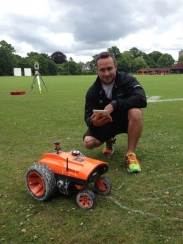Search the latest and greatest job opportunities in sport

By Adrian Hill, Sports Journalist for Running Rugby and Graphics Producer for BT Sport .
First published and written for Running Rugby .
The appearance of logos on rugby pitches has been one of the biggest steps forward in ensuring that sponsors get the most exposure possible for their brands, yet the process to get them there has been time-consuming.
Anyone arriving early at an Aviva Premiership ground would see a team of people studiously marking out the sponsor’s logo across the middle of the playing surface before adding the required colours to the natural green canvas. Every aspect of the design has to be applied rigorously, which inevitably takes time.
How to maintain the essential accuracy and attention to detail while working more efficiently with fewer man-hours is a Rubicon that Signaway claim they have crossed with the development of a machine which, we are told, follows instructions literally to the letter.
The Weybridge-based company, in association with Australian firm Grassads, have developed a robotic device (pictured above with chief operator Trevor Marks) which allows them to complete the painstaking task more efficiently.
“We used to go to a venue to do a survey, then come back and make the designs, plot them 1:1 on a plotter, cut out a stencil and then have to go back to create the design on the pitch. Now we can go to the venue and do the designs there. It’s a robotic function. Signals are sent to the robot at the rate of 50 signals per second, using a compass designed for military use, the most accurate in the world, so it always knows where it is. It saves a lot of time, with the plotting out etc, in terms of staff time,” Signaway’s Greg Craigen tells Running Rugby.
Even with the automated help, the lettering task alone at each of the recent JP Morgan Asset Management Premiership Rugby 7s events took an epic one-and-a-half hours to complete, but Craigen says that is still a big improvement as his staff can now concentrate on completing the design while the machine trundles around doing the marking out.
“When we marked out a logo we would have three to four staff involved. With the robot we can have just two people on site and there is less wear and tear on the grass. As the robot plots it out our staff go behind it,” he says.
In addition to the Premiership 7s, the robot was used at the Aviva Premiership final in May and the Rugby World Cup Sevens in Moscow in June. Signaway have two machines in use all the time, plus another in reserve as a back-up. The plan is to utilise them throughout the Aviva Premiership, RaboDirect PRO12 and LV Cup seasons, plus the autumn internationals and the RBS Six Nations.
In theory, the digitalisation of the process could open up new avenues for marketing campaigns as logos can be tweaked at short notice.
“We used to have to do a 10 metre x 10 metre stencil, whatever the design was,” adds Craigen. “Now, with the computer programme, we have the flexibility to change it, on site, to 20m x 20m if required. The process has gone digital. If a sponsor wants to change a logo on the day, by adding a strapline for instance, we can do it.
“Now we can change logos at the last minute. If a sponsor wants to run a campaign for insurance, for instance, we can adjust the logo to suit that requirement.”
The build-up to the London 2012 Olympics was highlighted for travellers arriving at Heathrow by a giant image of heptathlete Jessica Ennis painted on to the grass by Signaway for British Airways at Thornbury Playing Fields in Isleworth, a public open space along the flight path.
Such eye-catching designs create impact, with an estimated 100,000 people each day viewing the image en route to the airport and the associated publicity, yet such projects have long lead-up times. If the use of the robot can reduce these it could open the way for more such large-scale advertising.
With dozens of grounds to work at - from Exeter to Edinburgh and Galway to London - travelling time is another serious issue for the sign-makers but the digitalisation of the process should reduce their air miles significantly, and not just in the field of rugby.
“The great thing is the flexibility,” claims Craigen. “We used to have to fly to the West Indies, fly round all the islands, come back to design and plot and then go out there again for the event. Now we can do it all on site.”
No financial figures associated with the development were provided by Signaway to Running Rugby.
To see more rugby business stories, visit www.runningrugby.com .
Search the latest and greatest job opportunities in sport